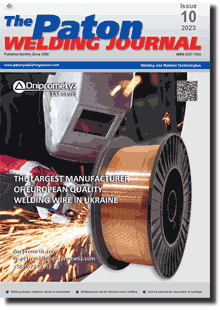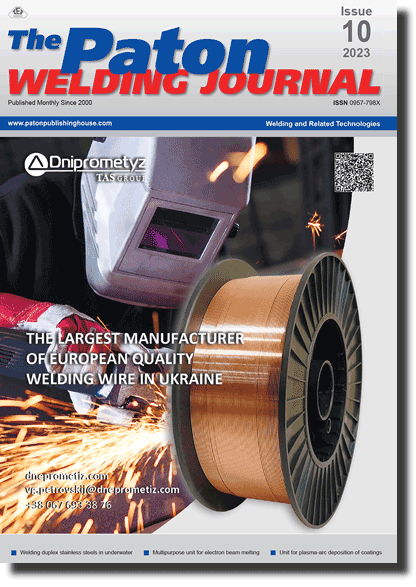| 2023 №10 (03) |
DOI of Article 10.37434/tpwj2023.10.04 |
2023 №10 (05) |

The Paton Welding Journal, 2023, #10, 24-29 pages
Studying the influence of duration of mechanochemical synthesis of nanostructured (Fe, Ti)3 Al powder on characteristics of plasma coatings
O.P. Gryshchenko1, N.V. Vihilianska1, O.M. Burlachenko1, C. Senderowski2, V.F. Gorban3
1E.O. Paton Electric Welding Institute of the NASU.. 11 Kazymyr Malevych Str., 03150, Kyiv, Ukraine. E-mail: grinya3679@gmail.com2Warsaw University of Technology, Narbutta 85 str. 02-524 Warsaw, Poland
3Institute of Problems of Materials Science. I.M. Fransevich NAS of Ukraine. 3 Academician Krzhizhanovsky, 03142 Kyiv
Abstract
The impact of duration of high-energy processing of the mixture of 60.8Fe + 39.2TiAl powders (wt. %) on structure, phase composition and mechanical characteristics of plasma intermetallic (Fe,Ti)3Al coatings was studied. As powders, for plasma spraying powders of (Fe,Ti)3Al intermetallic were used, which were produced by the method of mechanochemical synthesis (MChS) in a high-energy mill for 3 and 5 h. As a result of plasma spraying, coatings with a nanocrystalline structure with the size of crystallites of 60 and 45 nm are formed, respectively. It was shown that during spraying of MChS-powder, produced during 5 h, thin-lamellar coatings with a maximum thickness of lamellae of 23 μm are formed, whereas in the case of spraying of MChS-powder produced within 3 h, the thickness of lamellae reaches 42 μm. At the same time, in the case of spraying MChS powder, produced within 5 h, more dense coatings are formed, the porosity of which is reduced by 2.3 % compared to the coating from the MChS-powder, produced within 3 h. It was established that mechanical characteristics (hardness and module of elasticity) of the plasma coating were increased when using a powder produced by processing within 5 h. This allows predicting higher wear resistance of these coatings, operating in the conditions of wear unlike the case of spraying MChS-powder, produced within 3 h. 15 Ref., 3 Tabl., 5 Fig.
Keywords: iron aluminides, mechanochemical synthesis, plasma spraying, nanostructural coatings, crystalline size, mechanical characteristics
Received: 28.06.2023
Accepted: 14.11.2023
References
1. Cinca, N., Lima, C. R. C., Guilemany, J. M. (2013) An overview of intermetallics research and application: Status of thermal spray coatings. J. of Materials Research and Technology, 2(1), 75-86 https://doi.org/10.1016/j.jmrt.2013.03.0132. Palm, M., Stein, F., Dehm, G. (2019) Iron aluminides. Annual Review of Materials Research, 49, 297-326. https://doi.org/10.1146/annurev-matsci-070218-125911
3. Zamanzade, M., Barnoush, A., Motz, C. (2016) A Review on the Properties of Iron Aluminide Intermetallics. Crystals, 6(1), 10. https://doi.org/10.3390/cryst6010010
4. Moszner, Peng, Suutala, Jasnau, Damani, Palm. (2019) Application of Iron Aluminides in the Combustion Chamber of Large Bore 2-Stroke Marine Engines. Metals, 9(8), 847. https://doi.org/10.3390/met9080847
5. Bahadur, A. (2003) Enhancement of high temperature strength and room temperature ductility of iron aluminides by alloying. Materials Science and Technology, 19(12), 1627- 1634. https://doi.org/10.1179/026708303225008266
6. Rafiei, M., Enayati, M.H., Karimzadeh, F. (2009) Characterization and formation mechanism of nanocrystalline (Fe, Ti)3Al intermetallic compound prepared by mechanical alloying. J. of Alloys and Compounds, 480(2), 392-396. https://doi.org/10.1016/j.jallcom.2009.02.072
7. Senderowski, C., Cinca, N., Dosta, S. et. al. (2019) The Effect of Hot Treatment on Composition and Microstructure of HVOF Iron Aluminide Coatings in Na2SO4 Molten Salts. J. of Thermal Spray Technology, 28(7), 1492-1510. https://doi.org/10.1007/s11666-019-00886-w
8. Fikus, B., Senderowski, C. Panas, A.J. (2019) Modeling of Dynamics and Thermal History of Fe40Al Intermetallic Powder Particles Under Gas Detonation Spraying Using Propane-Air Mixture. J. of Thermal Spray Technology, 28, 346-358. https://doi.org/10.1007/s11666-019-00836-6
9. Senderowski, C., Vigilianska, N., Burlachenko, O. et. al. (2023) Effect of APS Spraying Parameters on the Microstructure Formation of Fe3Al Intermetallics Coatings Using Mechanochemically Synthesized Nanocrystalline Fe-Al Powders. Materials, 16, 1669. https://doi.org/10.3390/ma16041669
10. Borisov, Yu.S., Borisova, A.L., Vihilyanska, N.V. et. al. (2021) Electric arc spraying of intermetallic Fe-Al coatings using different solid and powder wires. The Paton Welding J., 3, 16-21. https://doi.org/10.37434/tpwj2021.03.03
11. Borisov, Yu.S., Borisova, A.L., Burlachenko, A.N. et. al. (2017) Structure and properties of alloyed powders based on Fe3Al intermetallic for thermal spraying produced using mechanochemical synthesis method. The Paton Welding J., 9, 33-39. https://doi.org/10.15407/tpwj2017.09.06
12. Firstov, S.A., Gorban, V.F., Pechkovskiy, E.P. (2009) New procedure of treatment and analysis of results of automatic indentation of materials. Kyiv, Logos [in Russian].
13. Chen, X., Du, Y., Chung, Y.-W. (2019) Commentary on using H/E and H/E as proxies for fracture toughness of hard coatings. Thin Solid Films, 688, 137265. https://doi.org/10.1016/j.tsf.2019.04.040
14. Cui, C, Yang, C. (2023) Mechanical Properties and Wear Resistance of CrSiN Coating Fabricated by Magnetron Sputtering on W18Cr4V Steel. Coatings, 13(5), 889. https://doi.org/10.3390/coatings13050889
15. Beake, B. (2022) The influence of the H/E ratio on wear resistance of coating systems - Insights from small-scale testing. Surface and Coatings Technology, 442, 128272. https://doi.org/10.1016/j.surfcoat.2022.128272
Suggested Citation
O.P. Gryshchenko, N.V. Vihilianska, O.M. Burlachenko, C. Senderowski, V.F. Gorban (2023) Studying the influence of duration of mechanochemical synthesis of nanostructured (Fe, Ti)3 Al powder on characteristics of plasma coatings. The Paton Welding J., 10, 24-29.The cost of subscription/purchase order journals or individual articles
| Journal/Currency | Annual Set | 1 issue printed |
1 issue |
one article |
| TPWJ/USD | 384 $ | 32 $ | 26 $ | 13 $ |
| TPWJ/EUR | 348 € | 29 € | 24 € | 12 € |
| TPWJ/UAH | 7200 UAH | 600 UAH | 600 UAH | 280 UAH |
| AS/UAH | 1800 UAH | 300 UAH | 300 UAH | 150 UAH |
| AS/USD | 192 $ | 32 $ | 26 $ | 13 $ |
| AS/EUR | 180 € | 30 € | 25 € | 12 € |
| SEM/UAH | 1200 UAH | 300 UAH | 300 UAH | 150 UAH |
| SEM/USD | 128 $ | 32 $ | 26 $ | 13 $ |
| SEM/EUR | 120 € | 30 € | 25 € | 12 € |
| TDNK/UAH | 1200 UAH | 300 UAH | 300 UAH | 150 UAH |
| TDNK/USD | 128 $ | 32 $ | 26 $ | 13 $ |
| TDNK/EUR | 120 € | 30 € | 25 € | 15 € |
AS = «Automatic Welding» - 6 issues per year;
TPWJ = «PATON WELDING JOURNAL» - 12 issues per year;
SEM = «Electrometallurgy Today» - 4 issues per year;
TDNK = «Technical Diagnostics and Non-Destructive Testing» - 4 issues per year.


